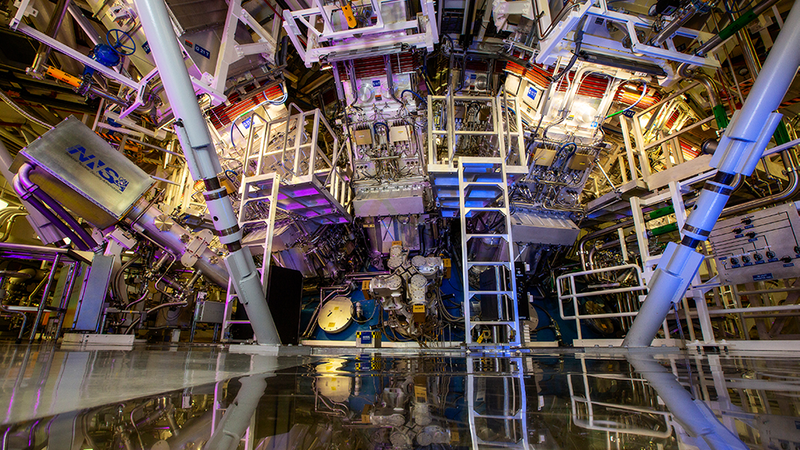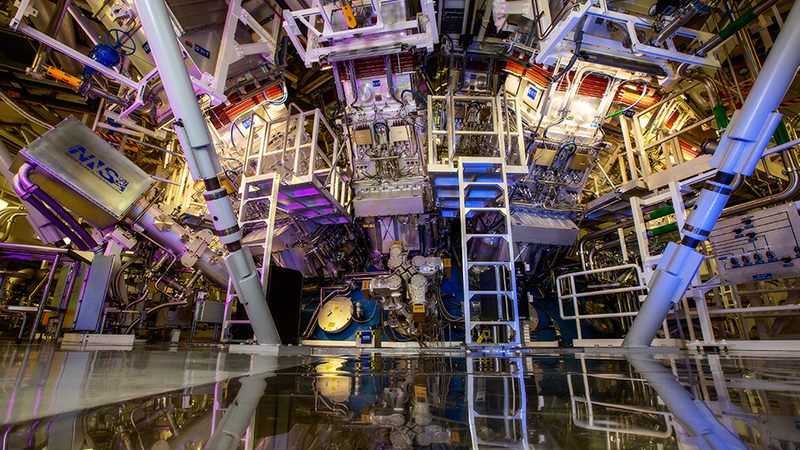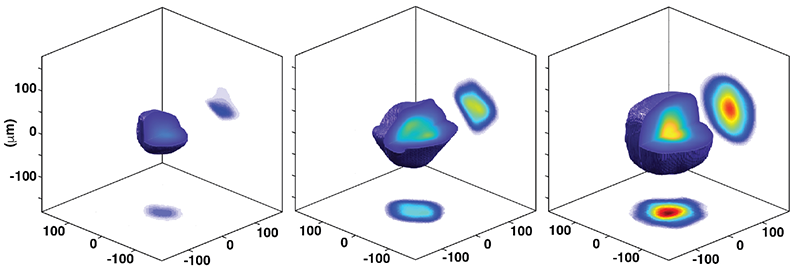Nuclear-Fusion Reaction Beats Breakeven
At a press briefing on December 13, 2022, researchers at the National Ignition Facility (NIF), California, reported a historic milestone on the road to practical fusion energy (see Research News: Gaining Ground in Nuclear Fusion): eight days earlier at 1:03 a.m. PST the team had recorded the first laser-powered fusion reaction that exceeded “scientific breakeven,” meaning it produced more energy than it consumed. Reports detailing that demonstration and the advances in technology it required have now completed peer review [1–5].
The facility at the NIF (Fig. 1) generates nuclear-fusion reactions via a technique called inertial confinement fusion. To drive the reactions, researchers fire the beams of 192 high-powered lasers at a millimeter-diameter cylinder that holds a high-density carbon capsule weighing 4.25 mg. That capsule is filled with 220 µg of deuterium and tritium (two forms of heavy hydrogen). When irradiated by lasers, the cylinder, which is known in the field as a hohlraum, acts like an extremely powerful x-ray oven, and it is designed so that the x rays uniformly bombard the surface of the fuel-containing capsule [6]. This process heats the capsule and causes the fuel to implode, leading the pressure (600 billion atmospheres) and temperature (151 million °C) of the fuel to significantly exceed those found in the Sun (200 billion atmospheres and 16 million °C). These conditions are sufficient for the deuterium and tritium atoms to fuse into helium and release energy.
Geometrical asymmetries in the fuel implosion can limit the efficiency of the kinetic-to-thermal energy conversion process required to ignite fusion and thus reduce the fusion energy the system ultimately releases. Such asymmetries can arise for a fuel capsule with walls that have an uneven thickness. Asymmetric implosion can also occur if the lasers nonuniformly irradiate the hohlraum.
Another issue that can reduce energy-conversion efficiency is the mixing of carbon into the deuterium–tritium fuel. Carbon can leach from the capsule’s wall into the fuel during the implosion process. This leaching is caused by hydrodynamic instabilities that are seeded by defects and inclusions created during the capsule fabrication process. Carbon contamination boosts radiative-energy loss from the system, increasing the laser energy required to achieve ignition. Over the past several years, the NIF researchers have put significant effort into fabricating higher-quality capsules that have more uniform walls and that contain fewer defects [1]. However, these capsules still contain a high number of inclusions.
Another key update that enabled the December 2022 result was the use of a capsule with a higher mass than in earlier experiments [7]. Increasing capsule mass must be done carefully, as it can amplify heating asymmetries in the capsule. However, the researchers showed that they could reduce the impact of this performance-degradation issue by increasing the energy of the lasers used to irradiate the hohlraum. Their capsule with 7% higher mass coupled with their laser energy increase of 0.15 megajoule (MJ) produced a higher-kinetic-energy implosion. This kinetic energy was sufficient to achieve a self-heating of the fuel that exceeded all heating losses (heat radiation and heat conduction from the fuel, as well as energy loses from fuel expansion), fulfilling the so-called ignition criterion.
In a further advance, the NIF team introduced a scheme—called crossbeam energy transfer—to reduce nonuniformity in the hohlraum that can limit symmetry of the fuel during implosion. Simulations show that this change, along with the others, enabled the increased fusion-energy output. This model, which the team developed using data from previous NIF experiments, predicted a high probability that the researchers would exceed scientific breakeven before the December 2022 experiment was performed.
Another key aspect in exceeding scientific breakeven was the volume of the reacting plasma inside the capsule. Analyzing the fusion-reaction region of experiments performed in March and August 2021, the NIF researchers found that a fourfold increase in the volume of this region corresponded to a 20-fold increase in the fusion-energy output (Fig. 2). The team attribute this energy output change to enhanced self-heating of the fuel by so-called alpha particles, which are produced in the fusion process. Each deuterium–tritium fusion reaction produces one neutron and one alpha particle. The neutron escapes from the target while the alpha particle heats the fuel, increasing fusion-energy output.
While the fusion energy reported lies well below the 300–500 MJ of electrical energy required to operate the system’s lasers, it is important to note that the efficiency of the NIF’s current flashlamp-pumped lasers has room for improvement. Switching out the flashlamps with modern high-power laser diodes could significantly reduce the electrical-energy consumption of the system, bringing it closer to the fusion yield.
These exciting developments signify a giant leap forward in the quest for a sustainable and low-carbon energy source. Though filled with scientific and technological challenges, such as improving efficiency, mass producing high-quality targets, achieving precisely positioned delivery of laser pulses, and increasing the resilience of infrastructure to products of the fusion reactions, the path ahead appears more promising than ever. Further progress made at the NIF will require collaborative efforts across academic, public, private, and international teams [8]. Continued innovation from all fields of science is crucial to overcoming the remaining challenges and unlocking the full potential of fusion energy [9].
References
- H. Abu-Shawareb et al. (Indirect Drive ICF Collaboration), “Achievement of target gain larger than unity in an inertial fusion experiment,” Phys. Rev. Lett. 132, 065102 (2024).
- A. L. Kritcher et al., “Design of the first fusion experiment to achieve target energy gain G > 1,” Phys. Rev. E 109, 025204 (2024).
- O. A. Hurricane et al., “Energy principles of scientific breakeven in an inertial fusion experiment,” Phys. Rev. Lett. 132, 065103 (2024).
- A. Pak et al., “Observations and properties of the first laboratory fusion experiment to exceed a target gain of unity,” Phys. Rev. E 109, 025203 (2024).
- M. S. Rubery et al., “Hohlraum reheating from burning NIF implosions,” Phys. Rev. Lett. 132, 065104 (2024).
- R. Betti and O. A. Hurricane, “Inertial-confinement fusion with lasers,” Nat. Phys. 12 (2016).
- H. Abu-Shawareb et al. (Indirect Drive ICF Collaboration), “Lawson criterion for ignition exceeded in an inertial fusion experiment,” Phys. Rev. Lett. 129 (2022).
- S. C. Hsu et al., “U.S. fusion energy development via public-private partnerships,” J. Fusion Energy 42 (2023).
- K. Okano et al., “An action plan of Japan toward development of demo reactor,” Fusion Eng. Des. 136 (2018).






